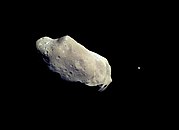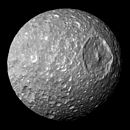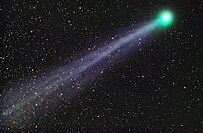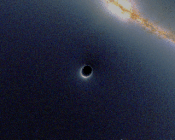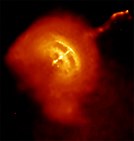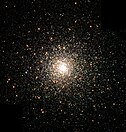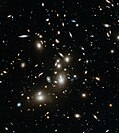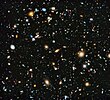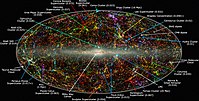Astronomical object
An astronomical object, celestial object, stellar object or heavenly body is a naturally occurring physical entity, association, or structure that exists within the observable universe.[1] In astronomy, the terms object and body are often used interchangeably. However, an astronomical body or celestial body is a single, tightly bound, contiguous entity, while an astronomical or celestial object is a complex, less cohesively bound structure, which may consist of multiple bodies or even other objects with substructures.
Examples of astronomical objects include
History
Astronomical objects such as
During the
In the 19th and 20th century, new technologies and scientific innovations allowed scientists to greatly expand their understanding of astronomy and astronomical objects. Larger telescopes and observatories began to be built and scientists began to print images of the Moon and other celestial bodies on photographic plates. New
Galaxy and larger
The universe can be viewed as having a hierarchical structure.[2] At the largest scales, the fundamental component of assembly is the galaxy. Galaxies are organized into groups and clusters, often within larger superclusters, that are strung along great filaments between nearly empty voids, forming a web that spans the observable universe.[3]
Galaxies have a variety of morphologies, with irregular, elliptical and disk-like shapes, depending on their formation and evolutionary histories, including interaction with other galaxies, which may lead to a merger.[4] Disc galaxies encompass lenticular and spiral galaxies with features, such as spiral arms and a distinct halo. At the core, most galaxies have a supermassive black hole, which may result in an active galactic nucleus. Galaxies can also have satellites in the form of dwarf galaxies and globular clusters.[5]
Within a galaxy
The constituents of a galaxy are formed out of gaseous matter that assembles through gravitational self-attraction in a hierarchical manner. At this level, the resulting fundamental components are the stars, which are typically assembled in clusters from the various condensing nebulae.[6] The great variety of stellar forms are determined almost entirely by the mass, composition and evolutionary state of these stars. Stars may be found in multi-star systems that orbit about each other in a hierarchical organization. A planetary system and various minor objects such as asteroids, comets and debris, can form in a hierarchical process of accretion from the protoplanetary disks that surround newly formed stars.
The various distinctive types of stars are shown by the
.Shape
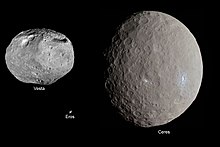
The
.Any natural Sun-orbiting body that has not reached hydrostatic equilibrium is classified by the IAU as a small Solar System body (SSSB). These come in many non-spherical shapes which are lumpy masses accreted haphazardly by in-falling dust and rock; not enough mass falls in to generate the heat needed to complete the rounding. Some SSSBs are just collections of relatively small rocks that are weakly held next to each other by gravity but are not actually fused into a single big bedrock. Some larger SSSBs are nearly round but have not reached hydrostatic equilibrium. The small Solar System body 4 Vesta is large enough to have undergone at least partial planetary differentiation.
Stars like the Sun are also spheroidal due to gravity's effects on their
Categories by location
The table below lists the general categories of bodies and objects by their location or structure.
| Solar bodies | Extrasolar | Observable universe | ||
|---|---|---|---|---|
| Simple bodies | Compound objects | Extended objects | ||
Planets
Dwarf planets
Minor planets
|
Stars (see sections below)
By luminosity / evolution
Compact stars
By
peculiar stars
By
spectral types |
Systems
Stellar groupings
Galaxies
|
Discs and media
Cosmic scale
|
|
See also
- List of light sources
- List of Solar System objects
- List of Solar System objects by size
- Lists of astronomical objects
- Outer space
References
- ^ Task Group on Astronomical Designations from IAU Commission 5 (April 2008). "Naming Astronomical Objects". International Astronomical Union (IAU). Archived from the original on 2 August 2010. Retrieved 4 July 2010.
{{cite web}}: CS1 maint: numeric names: authors list (link) - ISBN 81-7371-043-0.
- ISBN 0-19-512664-5.
- ISBN 978-0-521-82048-6.
- ISBN 0521318874. Retrieved 13 February 2017.
- .
- ISBN 0-387-20089-4.
External links
- SkyChart, Sky & Telescope at the Library of Congress Web Archives (archived 2005-06-13)
- Monthly skymaps for every location on Earth. Archived 2007-09-13 at the Wayback Machine.

